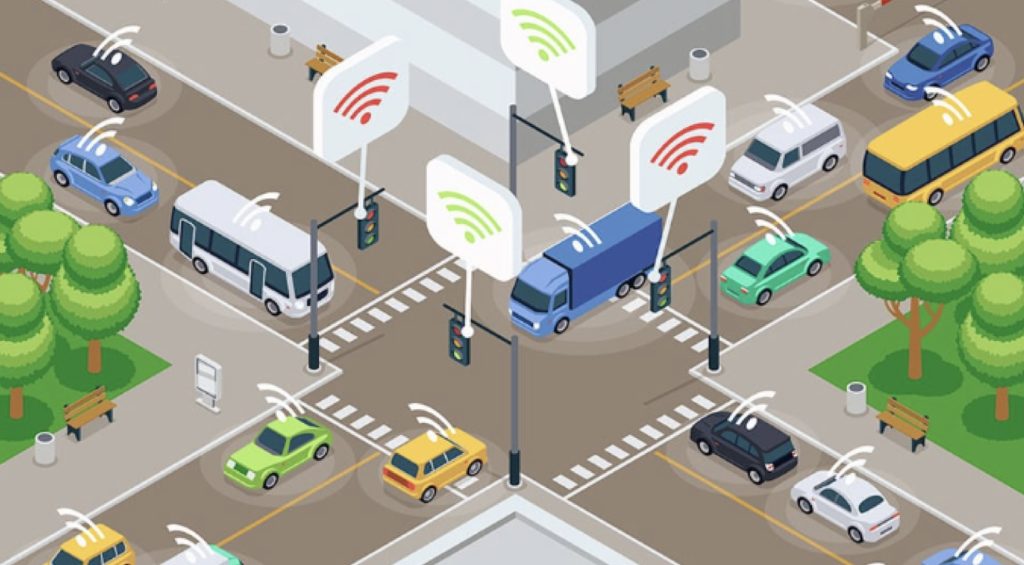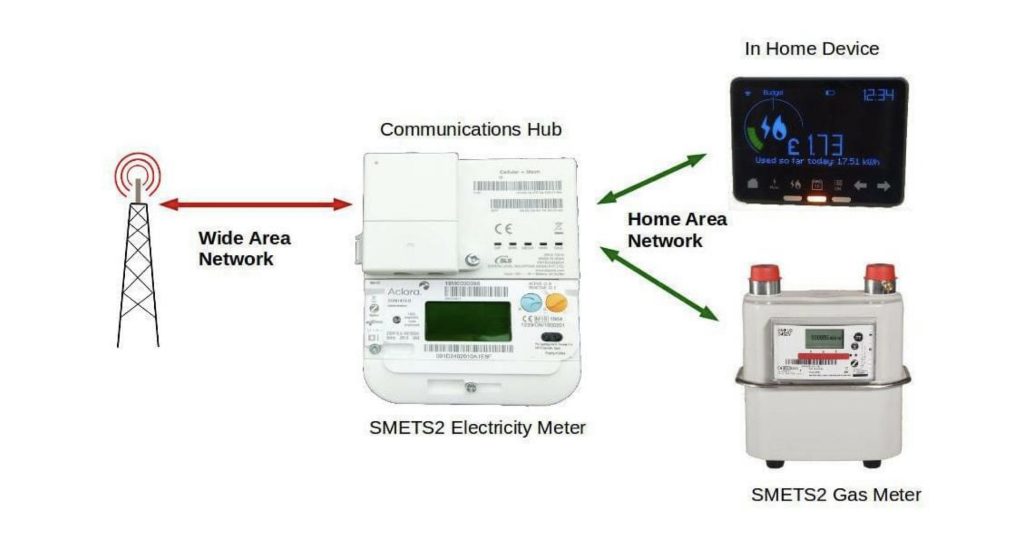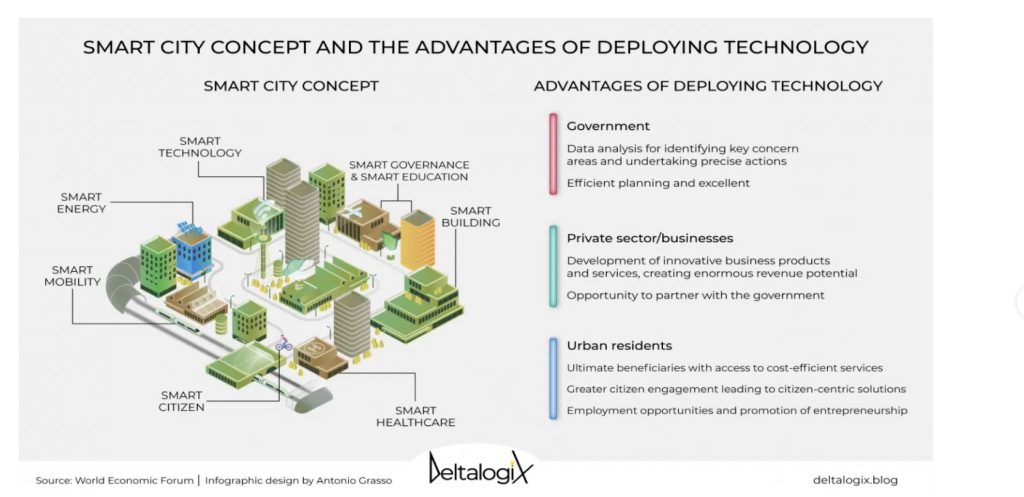1. Introduction
The number of persons living in urban locations has enlarged by more than a factor of six since 1950, reaching over 4 billion. The figure, by 2050 is predictable to increase to 3.5 billion. One of the solutions that is most promising to the substantial pressure that high expansion in population places on public services and urban infrastructure is the combination of the Internet of Things (IoT) and smart city. 1st century’s rapid urbanisation brings new difficulties and potentials to cities everywhere. Cities possess an increased demand for infrastructure, resources, and services as their populations rise. The concept of “smart cities” has achieved approval as a tool to handle difficulties and advance living in cities. IoT a network of networked sensors and gadgets that gather and share data, is exciting to this shift. By advancing infrastructure, maximising resource utilisation, and offering improved services to residents, IoT technologies assist cities in becoming smarter. This report explores the many facets of the (IoT-enabled smart city infrastructure.
2.Smart Transportation
IoT-enabled smart transportation system is an essential component of the smart city infrastructure that transforms urban mobility. It makes use of networked sensors and data analytics to improve traffic conditions and the commuter experience (Jan et al., 2019). Congestion is lessened, travel times are shortened, and less gas is used thanks to real-time traffic monitoring and adaptive traffic signal systems, all of which contribute to a decrease in emissions.

Figure 1: Smart City (Mazur, 2020)
Improvements in public transit made possible by the Internet of Things are both practical and efficient. Bus and rail arrival times are updated in real-time, allowing commuters to better plan their journeys. Congestion and emissions from driving aimlessly to seek parking spots are reduced with the use of IoT sensors integrated into smart parking systems.
Overall, smart transportation makes cities more accessible but also helps preserve the planet. It’s a model of how IoT technology might improve living conditions in smart cities by making transportation more convenient and less taxing on the environment (Fantin Irudaya Raj & Appadurai, 2022).
3.Smart City Technologies
The goal of smart city technology is to improve the quality of life in a city by addressing common problems like traffic congestion, pollution, and public safety.
Connected utility metres
The smart meter is a widely used Internet of Things device in the utility industry. These gadgets are installed on buildings and linked to a smart energy infrastructure to help utilities control the flow of electricity (Law & Lynch, 2019).

Figure 2: Connected utility metres
In addition, smart metres let people monitor their energy use, which may have a major cost effect. Insider Intelligence predicts that by 2035, smart metres will have saved utilities $157 billion.
Innovative Transport
The push to bring connected cars to the centre of public transportation has begun to yield dividends. By 2035, 97% of all automobiles registered in the United States are expected to be linked cars, according to a forecast by Insider Intelligence.
In particular, voice search and GPS coordinates capabilities are appealing to motorists, and as smart apps develop and expand, smart transportation will become more widespread.
Intelligent power grids
When it comes to the conservation of resources, smart grids are perhaps the most significant application of smart architecture and infrastructure. In Amsterdam, for instance, residents who are wired into the city’s smart grid have access to solar panels and energy storage units.
Since these batteries enable people to store power during times of low demand, they help reduce peak-hour grid stress (Inn, 2020). The photovoltaic cells also enable homeowners to sell any unused power back to the utility company.
4. Citizen Engagement
Citizen engagement, a vital component of smart city infrastructure enabled by IoT, empowers residents to actively participate in urban development and decision-making. Through digital platforms and mobile apps, citizens can report issues, access real-time data on air quality, traffic conditions, and public transportation schedules, and provide feedback on city services (Simonofski et al., 2017).
IoT technologies facilitate this engagement by collecting and disseminating relevant data, fostering transparency, and improving the overall quality of life for residents. Citizens gain a sense of ownership in their city’s progress, fostering a stronger sense of community.

Figure 3: Citizen Engagement (Ayanda, 2023).
Moreover, citizen-centric services can be tailored to individual preferences and needs, delivering personalized experiences. This not only enhances satisfaction but also allows cities to allocate resources more efficiently.
Citizen engagement driven by IoT technologies strengthens the relationship between city governments and residents (Tadili & Fasly, 2019). It promotes collaboration, transparency, and improved urban living conditions, making smart cities more inclusive and responsive to the needs of their citizens.
5.Public Safety
Incorporating locals into planning and provisioning is a crucial part of smart city infrastructure. A number of Internet of Things (IoT) technologies, including smartphone applications, social media, and citizen input platforms, make this possible (Tadili & Fasly, 2019). For instance, users may use smartphone applications to report problems like potholes or malfunctioning lamps, and IoT sensors can then check for and corroborate these reports, allowing for faster problem remediation.
As a further benefit, smart city systems offer people access to current data on topics such as traffic, air quality, and public transit times in real time. The capability to make informed choices is an essential component towards improving individual standards of living (Papadakis et al., 2021). Involving locals in urban planning and policymaking creates a feeling of belonging and pride in the city’s progress.
6. Future Prospects
The future of smart city infrastructure is promising, with IoT technologies continuing to evolve. Some trends and prospects include:
⦁ 5G Connectivity: The rollout of 5G networks will enable faster and more reliable communication between IoT devices, unlocking new possibilities for real-time data processing and applications (Lim, Cho, & Kim, 2021).
⦁ Edge Computing: Edge computing will become more prevalent, allowing data to be processed locally on IoT devices rather than relying solely on centralized cloud servers. This reduces latency and enhances real-time decision-making.
⦁ Artificial Intelligence: AI and machine learning will play an increasingly significant role in analysing IoT data to derive valuable insights and predict trends for more efficient city operations.
⦁ Environmental Sustainability: Smart city infrastructure will place even greater emphasis on sustainability, with IoT technologies helping cities reduce carbon emissions, manage waste more efficiently, and conserve natural resources (Ma, 2021).

Figure 4: Smart City Concept (Nardo, 2021)
⦁ Citizen-Centric Services: Cities will further enhance citizen engagement by delivering personalized services based on individual preferences and needs, improving the overall quality of life for residents.
7. Challenges and Considerations
While IoT-driven smart city infrastructure offers numerous benefits, it also presents challenges and considerations that must be addressed:
⦁ Privacy and Security: The vast amount of data collected by IoT devices raises concerns about citizen privacy and data security. Robust cybersecurity measures and data protection regulations are essential (Singh et al., 2021).
⦁ Interoperability: IoT devices and systems from various vendors must seamlessly work together for optimal efficiency. Standards and protocols are needed to ensure interoperability.
⦁ Infrastructure Investment: Developing and maintaining IoT infrastructure requires significant investment. Cities must carefully plan and budget for these projects.
⦁ Digital Divide: Ensuring equitable access to IoT-enabled services is crucial. Efforts should be made to bridge the digital divide and prevent exclusion of marginalized communities (Lim, Kim, & Maglio, 2018).
⦁ Data Governance: Cities must establish clear data governance policies to manage the vast amount of data generated by IoT devices responsibly.
8. Conclusion
IoT is powering smart city infrastructure that is revolutionising how cities are constructed. Cities may enhance the standard of life for their residents by implementing IoT solutions that boost productivity and durability. Significant elements of this shift encompass the implementation of smart transportation systems, managing energy, safety measures, and involvement from the community. Realising the full potential of smart cities, nevertheless, involves addressing issues of security, confidentiality, interoperability, and electronic inclusion. Smart cities offer a model for better-connected and more effective urban centres throughout the globe, and their future is bright thanks to continued technical breakthroughs and a dedication to citizen-centric solutions.
9. References
Alsamhi, S. H., Ma, O., Ansari, M. S., & Gupta, S. K. (2019). Collaboration of drone and internet of public safety things in smart cities: An overview of qos and network performance optimization. Drones, 3(1), 13.
Ayanda, K.E (2023). Citizen Engagement for Smart City Performance Management [LinkedIn post]. https://www.linkedin.com/pulse/citizen-engagement-smart-city-performance-management-urban-ayanda
Bull, R., Dooley, K., & Mazhar, M. (2019). The crucial role of citizen involvement in smart city development and operation. DOI:10.1680/emsc.64256.211
Fantin Irudaya Raj, E., & Appadurai, M. (2022). Internet of things-based smart transportation system for smart cities. In Intelligent Systems for Social Good: Theory and Practice (pp. 39-50). Singapore: Springer Nature Singapore.
Inn, T. L. (2020). Smart city technologies take on COVID-19. World Health, 841, 1-10.
Jan, B., Farman, H., Khan, M., Talha, M., & Din, I. U. (2019). Designing a smart transportation system: An internet of things and big data approach. IEEE Wireless Communications, 26(4), 73-79.
Law, K. H., & Lynch, J. P. (2019). Smart city: Technologies and challenges. IT Professional, 21(6), 46-51.
Lim, C., Cho, G. H., & Kim, J. (2021). Understanding the linkages of smart-city technologies and applications: Key lessons from a text mining approach and a call for future research. Technological Forecasting and Social Change, 170, 120893.
Lim, C., Kim, K. J., & Maglio, P. P. (2018). Smart cities with big data: Reference models, challenges, and considerations. Cities, 82, 86-99.
Ma, C. (2021). Smart city and cyber-security; technologies used, leading challenges and future recommendations. Energy Reports, 7, 7999-8012.
Mazur, S. (2020). Introduction to Smart Transportation: Benefits. https://www.digi.com/blog/post/introduction-to-smart-transportation-benefits
Nardo, C, (2021, December 3). Smart City and Sustainability: What Will Be the Next Challenges? https://deltalogix.blog/en/2021/12/03/smart-city-and-sustainability-what-will-be-the-next-challenges/
Papadakis, N., Koukoulas, N., Christakis, I., Stavrakas, I., & Kandris, D. (2021). An IoT-based participatory antitheft system for public safety enhancement in smart cities. Smart Cities, 4(2), 919-937.
Simonofski, A., Asensio, E. S., De Smedt, J., & Snoeck, M. (2017, July). Citizen participation in smart cities: Evaluation framework proposal. In 2017 IEEE 19th conference on business informatics (CBI) (Vol. 1, pp. 227-236). IEEE.
Singh, J., Sajid, M., Gupta, S. K., & Haidri, R. A. (2022). Artificial Intelligence and Blockchain Technologies for Smart City. Intelligent Green Technologies for Sustainable Smart Cities, 317-330.
Tadili, J., & Fasly, H. (2019, October). Citizen participation in smart cities: A survey. In Proceedings of the 4th International Conference on Smart City Applications (pp. 1-6).


